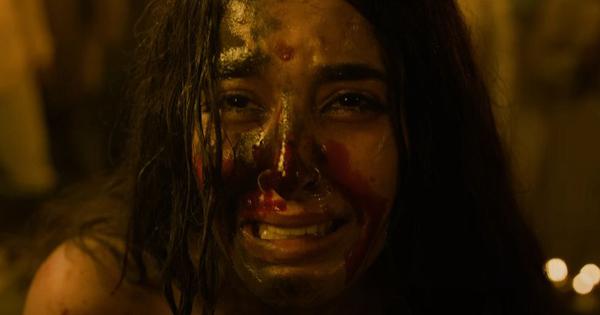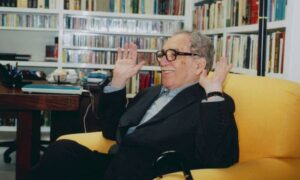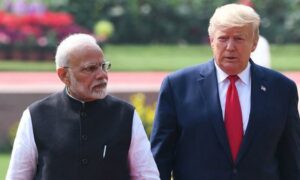
“Yeh Poschim Bongal hai, Poschim Bongal,” a seemingly Bengali policeman tells Pandit, his senior from Delhi, early on in director Vivek Agnihotri’s The Bengal Files. This is West Bengal.
He is trying to explain to Pandit why the local police cannot arrest associates of a powerful state legislator despite orders. Pandit (Darshan Kumaar) is unable to understand this throughout the 204-minute long film.
The story is set in present-day Murshidabad. Pandit, a Central Bureau of Investigation officer, has been sent there to investigate a sensitive case. The legislator Sardar Husseini (Saswata Chatterjee) is accused of abducting a young woman journalist. Phrases like “India-Bangladesh border”, “illegal immigration” and “fake documents” are bandied about to give us a vague sense of what the local strongman was up to.
Pandit discovers some chapters of colonial Bengal’s history. He learns about the Great Calcutta Killings of August 1946, the Noakhali riots of October-November 1946 and the straight line that apparently connects those two events to the so-called vote bank politics of today.
Pandit is informed that Bengal follows two Constitutions: one for Hindus and another for Muslims. Sardar Husseini’s henchmen cannot be arrested – it would lead to riots. When Pandit does arrest them, headlines flash on the screen to tell us that there has been a communal riot in Murshidabad.
“Is Bengal the next Kashmir?” one of the headlines asks. Summoned by his senior officer (Puneet Issar), Pandit delivers a monologue about the perils of unchecked illegal immigration, warning that it could lead to another Partition one day.
The Bengal Files is the latest instalment in the controversial Files series created by Agnihotri. In interviews before the film’s release, Agnihotri has claimed that his film was born out of meticulous research.
But the charade falls apart just minutes into the film. For starters, no Bengali attempting to speak in Hindi would refer to the state as “Bongal”. They would say Bengal or Bongo, but not “Bongal”. The oddness of this choice did not go unnoticed even in a Delhi theatre, where Hindi speakers guffawed at the mistake during the show that I watched.
The film is full of other bizarre elements, which Agnihotri tries to mask using a veneer of Bengali-sounding music and Bengali-looking set design. Iconic Bengali songs such as Kichudin Mone Mone and Dhono Dhannye Pushpe Bhora have been used in the film for no evident reason.
The background score breaks into Baul music every now and then. Characters randomly hold up the ektara – the single-string instrument popular among Baul musicians.
Portraits of Bengal’s renaissance men populate the screen almost all the time. They adorn the walls of people’s homes, their offices, the city and every other place. It is almost as if Agnihotri is trying to convince us that he knows enough Bengali men for his film to be taken seriously.
The rioting in Kolkata on Direct Action Day on August 16, 1946, is depicted without actually showing us the city. The Muslim League, which was then the ruling party of Bengal, had called a strike to demand a separate country for Muslims. The protests culminated in large-scale rioting across Kolkata.
Pandit frames the violence as part of a conspiracy to cause “demographic change” – an ongoing project supported by political parties for electoral gain, he claims.
These ideas are borrowed from contemporary Hindutva talking points. Incidentally, Prime Minister Narendra Modi announced the setting up of a High-Powered Demography Mission during his Independence Day speech last month. A week later, during a rally in Kolkata, Modi conjured up the spectre of infiltration and linked it to the Trinamool Congress government in West Bengal.
Such rhetoric is only expected to gather more steam as the 2026 Assembly elections in West Bengal draw closer. Agnihotri’s film is likely to add more fuel to this raging political fire in the state.
The Bengal Files opens with a few sentences to justify why Agnihotri has chosen to show only the Great Calcutta Killings and Noakhali riots. These events, the introduction says, were central to the Muslim League’s final push for securing a separate Muslim country by partitioning India. The film calls this the “most brutal genocide”.
Did the Congress leadership at that time agree to Partition after these two events? One does not need to read historical tomes to know that this is untrue. The recent web series Freedom At Midnight deals with the subject in a more balanced way while making the same point as Agnihotri: Partition was recklessly executed by people disconnected from ground realities.
Agnihotri has dedicated the film to “all the victims of communal violence”. In some scenes, he has inserted references to Hindutva symbols and slogans too.
For instance, Saswata Chatterjee’s legislator borrows a line from Uttar Pradesh Chief Minister Adityanath when he tells his followers, “Batenge toh katenge.” Divided we fall. He is also shown to be using a bulldozer to bury the bodies of his victims.
The Bengal Files shows communal violence in all its mindless brutality – with mostly Muslim perpetrators and Hindu victims who endure horrific violence.
But other than gore, the film has nothing perceptive to say about communal violence. It leaps from one scene to another without offering a diagnosis or even a coherent critique of the passions that drive people to commit horrific acts of violence on one another.
This article first appeared on Scroll.in
📰 Crime Today News is proudly sponsored by DRYFRUIT & CO – A Brand by eFabby Global LLC
Design & Developed by Yes Mom Hosting






